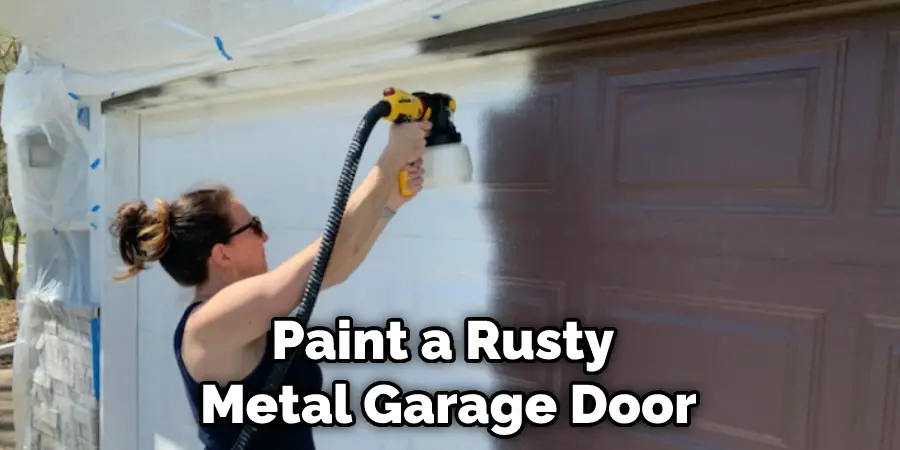Is your garage door starting to look a little rusty? Don’t worry; we’ve got you covered! In this blog post, we’re going to show you how to break garage door rust and get your door looking like new again. Follow these simple steps, and your garage door will be good as new!

Summary: If you’re dealing with a rusty garage door, there are several steps you can take to break the rust and get it working properly again. First, start by cleaning the rust off with a strong, rust-dissolving agent like vinegar or CLR. Once the rust is gone, sand down the affected areas with fine-grit sandpaper and apply a rust-inhibiting primer.
What Is Rust on A Garage Door?
Rust is one of the most common problems that homeowners face regarding their garage doors. Rust can occur for several reasons, typically caused by exposure to moisture or extreme weather conditions. Over time, rust will cause the metal on your garage door to weaken and eventually break down.
If left untreated, rust can also spread to other parts of your home, causing further damage. The best way to prevent rust is to regularly inspect your garage door for any signs of wear and tear. If you notice any rust, remove it immediately and apply a new coat of paint or sealant.
By taking these simple precautions, you can help keep your garage door looking like new for years to come.
Why It’s Important to Break Garage Door Rust?
Many homeowners don’t give much thought to their garage door until it stops working. However, taking the time to perform regular maintenance can help to prevent serious problems down the road. One issue that can cause major damage to a garage door is rust. Rust can cause the door to become severely weakened, and in some cases, it can even cause the door to break.
That’s why it’s so important to break garage door rust regularly. The best way to do this is to use a wire brush or sandpaper to remove the rust from the door’s surface. You may also need to use a special rust-removal solution to break down stubborn deposits. Taking these steps will help to keep your garage door in good working condition for many years to come.
How to Break Garage Door Rust Step by Step Guide
Step 1: Gather Necessary Tools and Materials
Before starting, gather the following tools and materials to break garage door rust effectively:
- Protective gloves
- Safety goggles
- Wire brush
- Sandpaper (various grits, ranging from 80 to 220)
- Rust converter
- Rust-inhibiting primer
- Paintbrush or paint roller
- Paint (specifically designed for metal surfaces)
- Painter’s tape
- Drop cloth or plastic sheeting
- White vinegar (optional)
- Clean cloth or rag
- Lubricant (silicone-based or garage door-specific)
Step 2: Inspect the Garage Door for Rust
Perform a thorough inspection of the garage door, paying close attention to areas where moisture may accumulate, such as the bottom of the door, joints, and hinges. Identify any areas affected by rust.
Step 3: Prepare the Workspace
Before beginning the rust removal process, prepare the workspace by placing a drop cloth or plastic sheeting on the floor beneath the rusted areas to catch debris. Tape off any areas surrounding the rusted sections that you do not want to be affected by the rust removal process using painter’s tape.
Step 4: Remove Loose Rust with a Wire Brush
Put on your protective gloves and safety goggles. Use the wire brush to remove any loose rust flakes from the affected areas. Be sure to scrub firmly but avoid applying excessive pressure that could damage the garage door’s surface.
Step 5: Sand the Rusted Areas
Using sandpaper, start with a lower grit (such as 80 or 100) and sand the rusted areas until the majority of the rust is removed. Gradually increase the grit of the sandpaper (120, then 220) to smooth the surface and remove any remaining rust particles. Wipe the area clean with a cloth or rag to remove dust and debris.
Step 6: Apply Rust Converter (Optional)
For more severe rust issues or areas with hard-to-remove rust, apply a rust converter to the affected areas according to the manufacturer’s instructions. The rust converter will chemically react with the rust, converting it into a stable, paintable surface. Allow the rust converter to dry as directed.
Step 7: Clean the Surface with White Vinegar (Optional)
If desired, you can clean the sanded and treated areas with white vinegar to neutralize any remaining rust particles. Soak a clean cloth or rag in white vinegar and gently wipe the surface. Allow the vinegar to sit for a few minutes, then wipe the area clean with a dry cloth or rag.
Step 8: Apply Rust-Inhibiting Primer
Once the rust has been removed and the surface is clean and dry, apply a rust-inhibiting primer to the affected areas using a paintbrush or paint roller. The primer will provide an additional layer of protection against future rust formation. Allow the primer to dry according to the manufacturer’s instructions.
Step 9: Paint the Treated Areas
After the primer has dried, apply a coat of paint specifically designed for metal surfaces to the treated areas. Use a paintbrush or paint roller to apply the paint evenly, ensuring full coverage of the primer. Allow the paint to dry as directed, and apply additional coats as needed for optimal coverage and protection.
Step 10: Remove Painter’s Tape and Clean Up
Once the paint is dry, carefully remove the painter’s tape and dispose of the drop cloth or plastic sheeting. Clean your tools and store them properly for future use.
Step 11: Lubricate Moving Parts
To prevent rust from forming on moving parts such as hinges, rollers, and tracks, apply a silicone-based lubricant or a garage door-specific lubricant. Regular lubrication will help to minimize friction and wear, reducing the likelihood of rust formation Step 12: Inspect Weatherstripping and Seals
Examine the garage door’s weatherstripping and seals for signs of wear or damage. If necessary, replace them to ensure a proper seal against moisture, which can contribute to rust formation.
Step 13: Check for Proper Drainage
Inspect the area around your garage door for proper drainage. If water tends to pool near the door, consider installing or improving your drainage system to prevent moisture from accumulating and promoting rust development.
Step 14: Maintain Proper Ventilation
Ensure that your garage has adequate ventilation to prevent condensation and moisture buildup. Proper airflow can help to minimize the humidity levels in your garage, reducing the risk of rust formation on your garage door.
Step 15: Regularly Clean and Inspect Your Garage Door
Establish a routine for cleaning and inspecting your garage door. Regular cleaning can help to prevent the buildup of dirt and debris that may trap moisture against the door’s surface. During inspections, pay close attention to areas prone to rust and address any issues promptly.
Step 16: Apply a Protective Coating (Optional)
For added protection against rust, consider applying a protective coating to your garage door, such as a rust-resistant paint or a clear sealant. These coatings can help to create a barrier against moisture, reducing the likelihood of rust formation.
Step 17: Monitor and Address Rust Issues Promptly
Stay vigilant and monitor your garage door for any signs of rust. If you notice any areas affected by rust, address them immediately by following the steps outlined above. Prompt action can help to prevent the rust from spreading and causing further damage.
By following these steps, you can effectively break garage door rust and protect your garage door from future rust formation. Regular maintenance, proper ventilation, and addressing rust issues promptly can help to ensure the longevity and functionality of your garage door.
What Is the Cheapest Way to Break a Garage Door Rust?
The cheapest way to break a garage door rust is by using a chisel and hammer. This will take some elbow grease, but it will be worth it. You may need to use a few different-sized chisels to get the job done right. First, use the chisel to score the rust. Next, use the hammer to break the rust off into small pieces.

Finally, use a wire brush to remove any residual rust. This process may need to be repeated a few times to remove all rust completely. However, once you have broken the rust off, you will have a clean surface ready for paint or a new sealant.
Can You Paint Over Rust on A Garage Door?
Rust is a major enemy of metal surfaces like garage doors. Left unchecked, it can quickly cause extensive damage that is unsightly and expensive to repair. The good news is that, in many cases, rust can be effectively treated with a coat of paint. Painting over rust may not be a permanent solution, but it can buy you some time.
Just make sure to prepare the surface before you start painting properly. Begin by sanding away any loose rust and then apply a primer specifically designed for use on rusty surfaces. Once the primer has had a chance to dry, you can then apply your top coat of paint.
With proper preparation, painting over rust can be an effective way to stave off further damage and extend the life of your garage door. Keep reading for more information about how to break garage door rust.
How Do You Paint a Rusty Metal Garage Door?
Garage doors take a lot of abuse. They have to withstand the elements year-round and the bumps and scrapes that come from daily use. Over time, this can lead to rust and other damage.

If your garage door is starting to look a little worse for wear, you may be wondering how to repaint it. The good news is that repainting a rusty metal garage door is fairly easy. Here are the steps you need to take:
First, clean the door with a degreaser or TSP solution. This will remove any dirt, grease, or grime that could prevent the paint from adhering properly. Next, sand down the door to remove any flaking paint or rust. Be sure to wear a dust mask while sanding to avoid inhaling any particles. Once the door is sanded, wipe it down with a damp cloth to remove any dust.
Now you’re ready to paint! Use a high-quality metal primer and paint designed for use on garage doors. First, apply two coats of primer, allowing each coat to dry completely before moving on to the next. Once the primer is dry, apply two coats of paint in your desired color.
Again, allow each coat to dry completely before applying the next. Once the paint is dry, your door will look good as new!
Consider investing in a garage door sealant if you want to protect your newly painted garage door from future rust and damage. This will create a barrier between the metal and the elements, helping to prolong the life of your door.
Conclusion
Rust can be a big problem for garage doors, but it’s easy to fix. By following the simple steps in this article, you can restore your door to its former glory and keep it looking great for years to come. Thanks for reading our post about how to break garage door rust. Have you tried any of these methods?
You Can Check It Out to Fix Cable on Garage Door
I am Rick. I grew up helping my dad with his handyman service. I learned a lot from him about how to fix things, and also about how to work hard and take care of business. These days, I’m still into fixing things- only now, I’m doing it for a living.
I’m always looking for new ways to help people grow and develop. That’s why I have created this blog to share all my experience and knowledge so
that I can help people who are interested in DIY repair.

